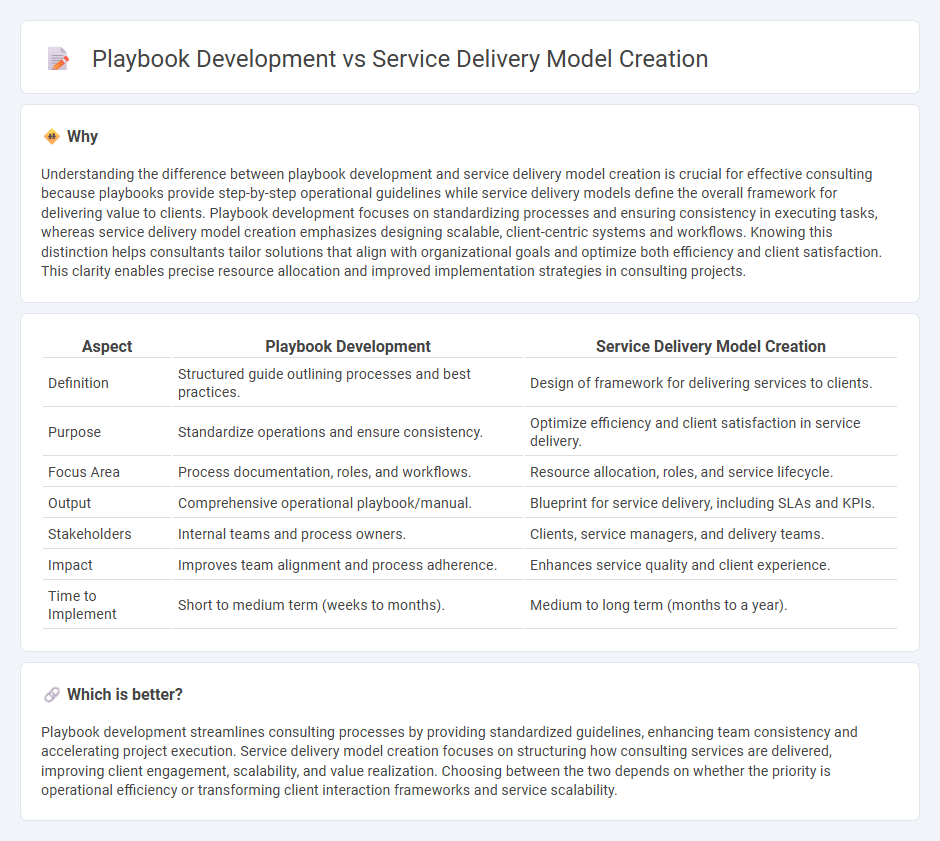
Developing a playbook in consulting involves creating a comprehensive guide that standardizes processes, best practices, and methodologies to ensure consistent project execution across teams. In contrast, designing a service delivery model focuses on defining how consulting services are structured, delivered, and managed to meet client needs effectively and optimize resource allocation. Explore our detailed insights to understand which approach aligns best with your consulting objectives.
Why it is important
Understanding the difference between playbook development and service delivery model creation is crucial for effective consulting because playbooks provide step-by-step operational guidelines while service delivery models define the overall framework for delivering value to clients. Playbook development focuses on standardizing processes and ensuring consistency in executing tasks, whereas service delivery model creation emphasizes designing scalable, client-centric systems and workflows. Knowing this distinction helps consultants tailor solutions that align with organizational goals and optimize both efficiency and client satisfaction. This clarity enables precise resource allocation and improved implementation strategies in consulting projects.
Comparison Table
| Aspect | Playbook Development | Service Delivery Model Creation |
|---|---|---|
| Definition | Structured guide outlining processes and best practices. | Design of framework for delivering services to clients. |
| Purpose | Standardize operations and ensure consistency. | Optimize efficiency and client satisfaction in service delivery. |
| Focus Area | Process documentation, roles, and workflows. | Resource allocation, roles, and service lifecycle. |
| Output | Comprehensive operational playbook/manual. | Blueprint for service delivery, including SLAs and KPIs. |
| Stakeholders | Internal teams and process owners. | Clients, service managers, and delivery teams. |
| Impact | Improves team alignment and process adherence. | Enhances service quality and client experience. |
| Time to Implement | Short to medium term (weeks to months). | Medium to long term (months to a year). |
Which is better?
Playbook development streamlines consulting processes by providing standardized guidelines, enhancing team consistency and accelerating project execution. Service delivery model creation focuses on structuring how consulting services are delivered, improving client engagement, scalability, and value realization. Choosing between the two depends on whether the priority is operational efficiency or transforming client interaction frameworks and service scalability.
Connection
Playbook development standardizes consulting best practices, ensuring consistent methodologies and processes that enhance service delivery. Service delivery model creation leverages these playbooks to define roles, responsibilities, and workflows, optimizing client engagement and outcomes. Together, they streamline project execution, improve efficiency, and drive scalable, high-quality consulting services.
Key Terms
Framework Design (Service delivery model creation)
Framework design in service delivery model creation establishes the foundational structure for aligning resources, processes, and technologies to achieve operational efficiency and customer satisfaction. This approach prioritizes scalable, repeatable workflows and clear performance metrics, enabling consistent service quality and agile adaptation to market demands. Explore how a well-crafted service delivery framework can transform your organizational capabilities and drive sustainable growth.
Standard Operating Procedures (Playbook development)
Service delivery model creation defines the overall framework for delivering services, including roles, processes, and technology integration, while playbook development centers on crafting detailed Standard Operating Procedures (SOPs) to ensure consistent execution of tasks within that framework. SOPs within playbooks enhance operational consistency, reduce errors, and streamline training by providing step-by-step instructions tailored to specific service scenarios. Explore how integrating service delivery models with comprehensive playbooks optimizes efficiency and service quality.
Client Experience Mapping (Service delivery model creation)
Service delivery model creation emphasizes Client Experience Mapping by designing processes that align service interactions with client expectations and journey stages, ensuring consistent value delivery and satisfaction. Playbook development documents standardized procedures and best practices, serving as a practical guide for operational teams but lacks the strategic client journey perspective found in service delivery models. Explore deeper insights into how Client Experience Mapping transforms service delivery strategies for enhanced client engagement.
Source and External Links
A Beginner's Guide to Service Delivery Models - Argano - Building a service delivery model involves establishing a strong service culture based on company values, encouraging employee engagement, maintaining service quality, and focusing on customer experience to clearly define roles, responsibilities, and expectations.
Service Delivery Models in Family Services - Number Analytics - Service delivery models can be in-house, outsourced, or collaborative, each with distinct characteristics regarding control, expertise, and service coordination, providing a conceptual framework for how services are delivered to clients.
Approach to Evaluating Your Institution's Service Delivery Model - Huron Consulting Group - Creating or optimizing a service delivery model involves a five-phase strategic approach: planning goals and governance, evaluating current state, designing the future model, implementing changes, and ongoing optimization to sustain results.
 dowidth.com
dowidth.com